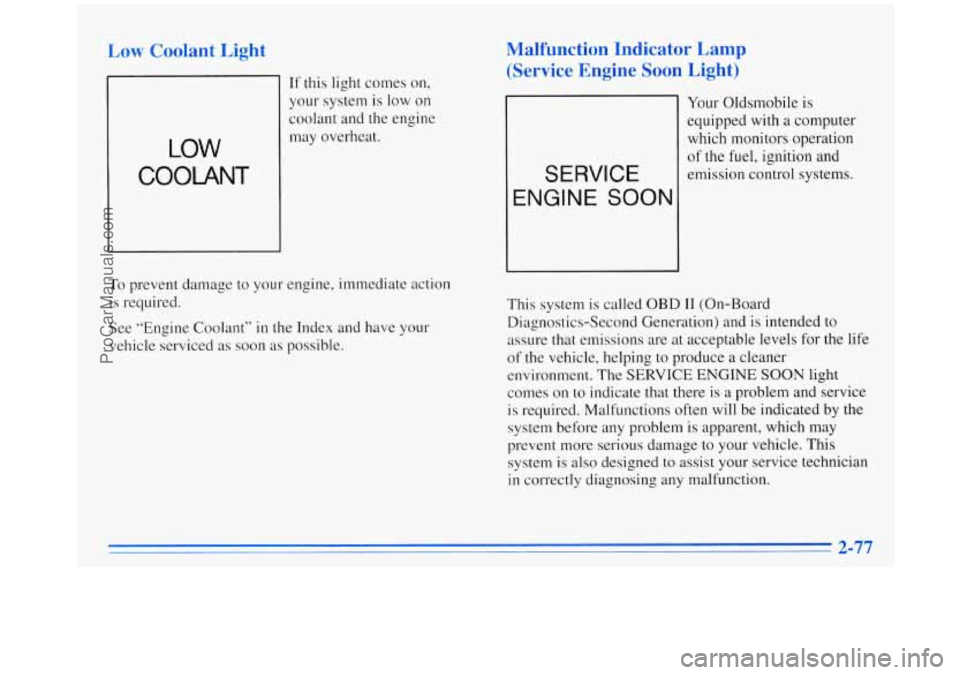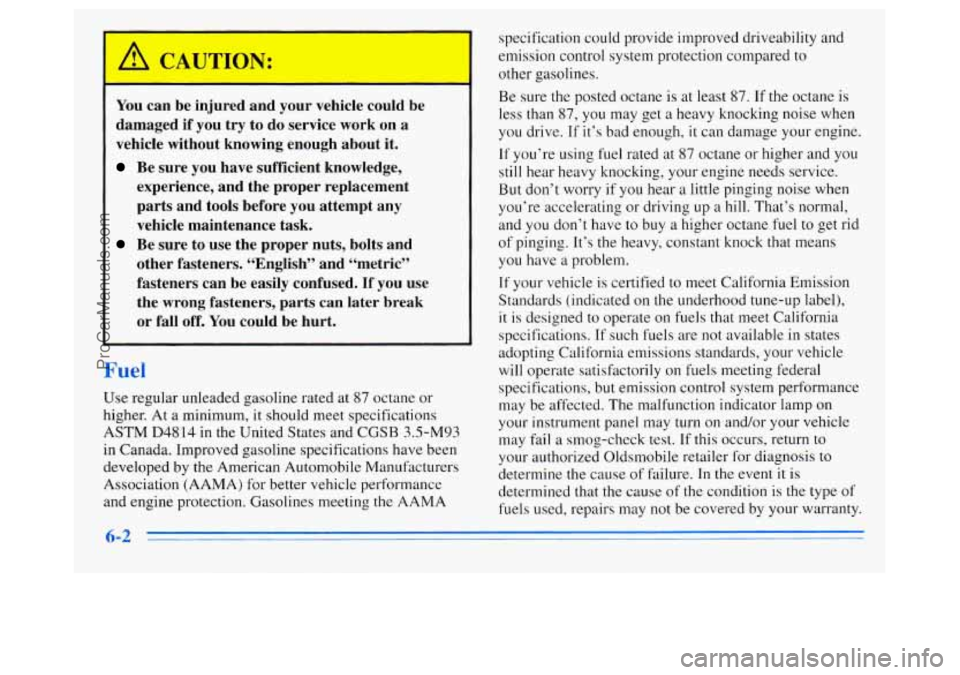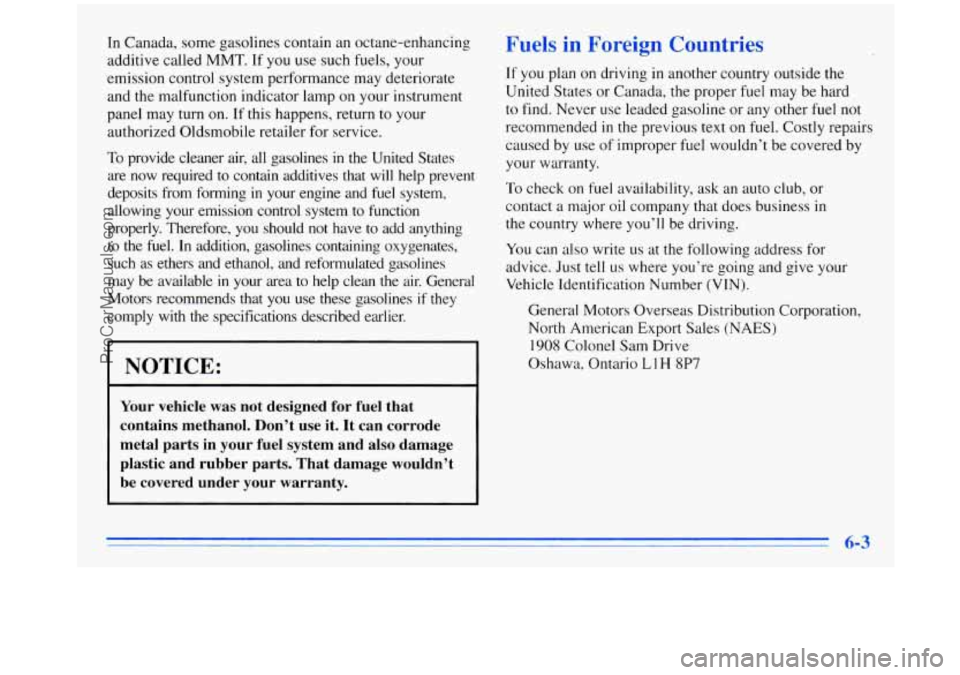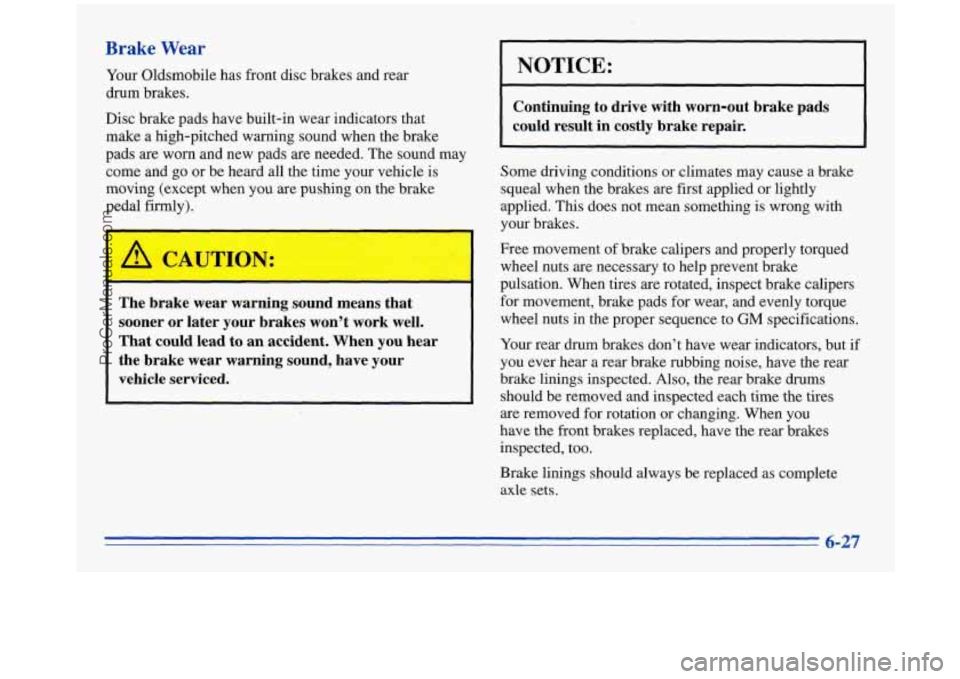service indicator OLDSMOBILE SILHOUETTE 1996 Owners Manual
[x] Cancel search | Manufacturer: OLDSMOBILE, Model Year: 1996, Model line: SILHOUETTE, Model: OLDSMOBILE SILHOUETTE 1996Pages: 372, PDF Size: 19.39 MB
Page 141 of 372

Low Coolant Light
I i LOW
If this light comes on,
your system is low on
coolant and the engine
may overheat.
Malfunction Indicator Lamp
(Service Engine
Soon Light)
SERVICE
ENGINE SOON
Your Oldsmobile is
equipped with a computer
which monitors operation
of the
fuel, ignition and
emission control systems.
To prevent damage to your engine, immediate action
is required.
See “Engine Coolant”
in the Index and have your
vehicle serviced
as soon as possible. This
system is called
OBD I1 (On-Board
Diagnostics-Second Generation) and
is intended to
assure that emissions are at acceptable levels for the life
of the vehicle, helping to produce
a cleaner
environment. The
SERVICE ENGINE SOON light
comes on to indicate that there is a problem and service
is required. Malfunctions often will be indicated by the
system before any problem is apparent, which may
prevent more serious damage to your vehicle. This
system is also designed to assist your service technician
in correctly diagnosing any malfunction.
ProCarManuals.com
Page 144 of 372

Oil Pressure Indicator
Your vehicle is equipped with an oil pressure indicator.
Your oil pressure indicator lets you know when you may
have
a problem with your engine oil pressure.
When the engine is running, readings
within the white
area indicate the normal operating range. Readings
in or
below the red area indicate that the engine's oil level
may be dangerously low, or there may be another
problem causing low
oil pressure. Driving your vehicle
with low
oil pressure can
cause extensive engine damage. Have your vehicle
serviced immediately.
' A CA"T1ON:
I-
Don't keep driving if the oil pressure is low. If
you do, your engine can become so hot that it
catches fire. You
or others could be burned.
Check your oil
as soon as possible and have your
vehicle serviced.
NOTICE:
Damage to your engine from neglected oil problems
can be costly and is not covered by your warranty.
2-80
ProCarManuals.com
Page 248 of 372

You can be injured and your vehicle could be
damaged if you try to do service work on a vehicle without knowing enough about it.
Be sure you have sufficient knowledge, experience, and the- proper replacement
parts and tools before you attempt any
vehicle maintenance task.
Be sure to use the proper nuts, bolts and
other fasteners. “English” and “metric”
fasteners can be easily confused.
If you use
the wrong fasteners, parts can later break
or fall
off. You could be hurt.
Fuel
Use regular unleaded gasoline rated at 87 octane or
higher. At a minimum, it should meet specifications
ASTM D4814 in the United States and CGSB 3.S-M93
in Canada. Improved gasoline specifications have been
developed by the American Automobile Manufacturers
Association (AAMA) for better vehicle performance
and engine protection. Gasolines meeting
the AAMA specification could provide improved driveability
and
emission control system protection compared to other gasolines.
Be sure
the posted octane is at least 87. If the octane is
less than
87, you may get a heavy knocking noise when
you drive.
If it’s bad enough, it can damage your engine.
If you’re using fuel rated at 87 octane or higher and you
still hear heavy knocking, your engine needs service.
But don’t worry
if you hear a little pinging noise when
you’re accelerating or driving up
a hill. That’s normal,
and you don’t have to buy
a higher octane fuel to get rid
of pinging. It’s the heavy, constant knock that means
you have
a problem.
If your vehicle is certified to meet California Emission
Standards (indicated on the underhood tune-up label),
it is designed to operate on fuels that meet California
specifications. If such fuels are not available
in states
adopting California emissions standards, your vehicle
will operate satisfactorily
on fuels meeting federal
specifications, but emission control system performance
may be affected. The malfunction indicator lamp on
your instrument panel may turn
on and/or your vehicle
may fail a smog-check test. If this occurs, return to
your authorized Oldsmobile retailer for diagnosis to
determine the cause of failure. In the event
it is
determined that the cause of the condition
is the type of
fuels used, repairs may not be covered by your warranty.
6-2
ProCarManuals.com
Page 249 of 372

In Canada, some gasolines contain an octane-enhancing
additive called MMT. If you use such fuels, your
emission control system performance may deteriorate
and the malfunction indicator lamp on your instrument
panel may turn on. If this happens, return to your
authorized Oldsmobile retailer for service.
To provide cleaner air, all gasolines in the United States
are now required to contain additives that will help prevent
deposits from forming in your engine and
fuel system,
allowing your emission control system to function
properly. Therefore,
you should not have to add anything
to
the fuel. In addition, gasolines containing oxygenates,
such as ethers and ethanol, and reformulated gasolines
may be available in your area
to help clean the air. General
Motors recommends that you use these gasolines
if they
comply with the specifications described earlier.
NOTICE:
Your vehicle was not designed for fuel that
contains methanol. Don’t use it. It can corrode
metal parts
in your fuel system and also damage
plastic and rubber parts. That damage wouldn’t
be covered under your warranty.
Fuels in Foreign Countries
If you plan on driving in another country outside the
United States or Canada, the proper fuel may be hard
to find. Never use leaded gasoline or any other fuel not
recommended in the previous text on fuel. Costly repairs
caused by use of improper fuel wouldn’t be covered by
your warranty.
To check on fuel availability, ask an auto club, or
contact a major oil company that does business in
the country where you’ll be driving.
You can also write us at the following address for
advice. Just tell us where you’re going and give your
Vehicle Identification Number (VIN).
General Motors Overseas Distribution Corporation,
North American Export Sales (NAES)
1908 Colonel Sam Drive
Oshawa, Ontario
Ll H 8P7
6-3
ProCarManuals.com
Page 273 of 372

Brake Wear
Your Oldsmobile has front disc brakes and rear
drum brakes.
Disc brake pads have built-in wear indicators that
make a high-pitched warning sound when the brake
pads are
worn and new pads are needed. The sound may
come and go or be heard all the time your vehicle is
moving (except when you
are pushing on the brake
pedal firmly).
The brake wear warning sound means that
sooner or later your brakes won’t work well.
That could lead to an accident. When
you hear
the brake wear warning sound, have your
vehicle serviced.
NOTICE:
Continuing to drive with worn-out brake pads
could result in costly brake repair.
Some driving conditions or climates may cause a brake
squeal when the brakes
are first applied or lightly
applied. This does not mean something is wrong with
your brakes.
Free movement of brake calipers and properly torqued
wheel nuts are necessary to help prevent brake
pulsation. When tires are rotated, inspect brake calipers
for movement, brake pads
for wear, and evenly torque
wheel nuts in the proper sequence to
GM specifications.
Your rear drum brakes don’t have wear indicators, but
if
you
ever hear a rear brake rubbing noise, have the rear
brake linings inspected. Also, the rear brake drums
should be removed and inspected each time the tires
are removed for rotation or changing. When you
have the front brakes replaced, have the rear brakes
inspected, too.
Brake linings should always be replaced
as complete
axle sets.
6-27
ProCarManuals.com
Page 284 of 372

!n It’s Vew Tires 0 The tire has a bump, bulge or split.
One way
to tell when it’s
time for new tires
is to
check the treadwear indicators, which will
appear when your tires have
only
1/16 inch (1.6 mm) or
less of tread remaining.
0 The tire has a puncture, cut or other damage that
can’t be repaired well because
of the size or location
of the damage.
Buyinp Nc - . .? Tires
To find out what kind and size of tires you need, look at
the CertificatiodTire label.
You need a new tire if any
of the following statements
are true:
0 You can see the indicators at three or more places
around the tire.
0 You can see cord or fabric showing through the
tire’s rubber.
0 The tread or sidewall is cracked, cut or snagged deep
enough to show cord or fabric. The
tires installed on your vehicle when it was new had
a Tire Performance Criteria Specification
(TPC Spec)
number on each tire’s sidewall. When
you get new tires,
get ones with that same TPC Spec number. That way
your vehicle will continue to have tires that are designed
to give proper endurance, handling, speed rating,
traction, ride and other things during normal service on
your vehicle. If your tires have an all-season tread
design, the TPC number will be followed by an
“MS”
(for mud and snow).
If you ever replace your tires with those not having a
TPC Spec number, make sure they are the same size,
load range, speed rating and construction type (bias,
bias-belted or radial) as your original tires.
3
ProCarManuals.com
Page 365 of 372

LockDelay ..................................... 2-9
Locking Storage Bin
............................ 2-59
Automatic Door
............................... 2-6
Cylinders
................................... 7-35
Door
........................................ 2-4
Key Lock Cylinder Service
..................... 7-35
Liftgate
..................................... 2-21
Power Door
.................................. 2-5
Sliding Door Security .......................... 2- 18
Steering Column Lock Check
................... 7-37
Low Coolant Warning Light
...................... 2-77
LowFuelLight
................................ 2-84
LowOilLight
................................. 2-81
Lubricants and Fluids
............................ 7-39
Lubrication Service. Body
........................ 7-35
Luggagecarrier
................................ 2-62
Locks
......................................... 2-4
. Sliding Door ................................. 2-13
Maintenance. Normal Replacement Parts
........... 6-60
Maintenance Record
............................ 7-4 1
Maintenance Schedule ............................ 7- 1
How the Section is Organized .................... 7-2
Long Trip/Highway Definition
................... 7-5
Long Trip/Highway Intervals
..................... 7-5
Owner Checks and Services
..................... 7-34
Periodic Maintenance Inspections
................ 7-38
Recommended Fluids and Lubricants
............. 7-39 Scheduled Maintenance Services
.................. 7-3
Short Trip/City Definition
....................... 7-4
Short Trip/City Intervals
........................ 7-4
Your Vehicle and the Environment
................ 7-1
Maintenance. Underbody ......................... 6-49
Maintenance When Trailer Towing
................. 4-37
Malfunction Indicator Lamp
...................... 2-77
Manual Front Seat
............................... 1-2
Matching Transmitters to Your Vehicle
.............. 2-10
Mirrors
....................................... 2-52
Convex Outside
.............................. 2-53
Inside Daymight Rearview
..................... 2-52
Power Remote Control
......................... 2-52
Visorvanity
................................. 2-65
Mode Buttons. Climate Control System
.............. 3-2
MountainRoads
................................ 4-21
Multifunction Lever
............................. 2-39
Net. Convenience .............................. 2-61
Neutral
....................................... 2-28
New Vehicle “Break-In”
......................... 2-22
Nightvision
................................... 4-14
odometer
.................................... 2-71
Odometer. Trip
................................. 2-72
Off-Road Recovery
............................. 4-10
Oil. Engine
..................................... 6-9
9-7
ProCarManuals.com